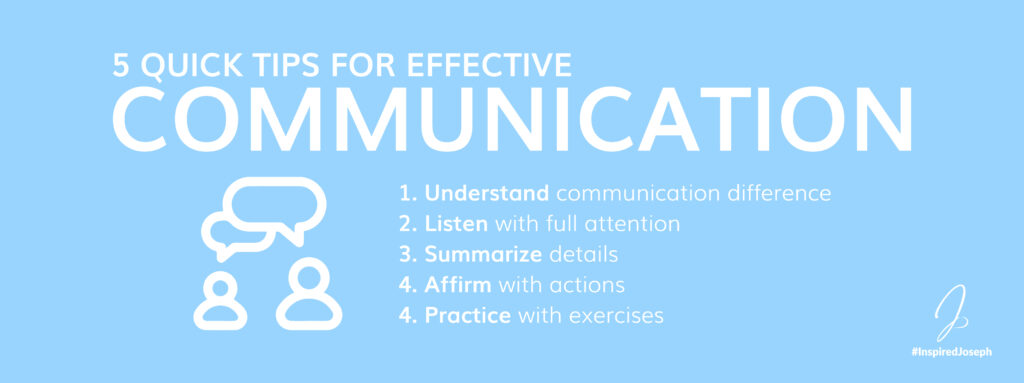6 Ways To Improve Communication In Workplace
the best skill to learn between managers and employees
Why Are Communication Skills Important?
The Importance of Good Communication at the Workplace provides numerous benefits. Specifically, it allows companies to become more agile and effectively align their workplaces. It improves employee morale, engagement, productivity, and job satisfaction. It also affects some of the most important KPIs for employee retention, concentration, motivation, and talent development.
"The ability to effectively communicate is a valuable asset in your pursuit of your objectives."
(Joseph L. Wong)
Effective Communication Here are 6 areas to explore as we work to improve our communication skills with one another.

Communication in the workplace is critical for businesses to operate efficiently and productively. Employees that can communicate across and within a company’s communication chain might experience higher morale, productivity, and dedication. Employers that invest time and effort in establishing open communication channels can quickly build employee trust, resulting in increased productivity, performance, and overall morale. On the other hand, employees who interact successfully with their colleagues, bosses, and customers remain significant assets to a company.
Poor workplace communication will undoubtedly result in unmotivated employees who begin to doubt their abilities and organizations. However, the value of effective communication is well recognised in the workplace. The following article will discuss the ways to improve communication in a workplace
Communication Style
0%
Challenges
0%
Cultural Context
0%
Listening
0%
Sharing
0%
Feedback
0%
Let’s investigate the 6 ways in which these points relate to the value of communication in the workplace:

Effective Communication Understand different communication styles
It’s important to remember that not everyone uses the same language or The 4 + 1 Communication Styles. People can either be very straightforward or very indirect. There are both bold and anxious individuals in the world. Some prefer to focus on internal experiences, while others favor external results. You are responsible for ensuring the other person or colleague understands your words in every communication circumstance. It is one of the most critical lessons on successful communication in the business. Consider this your starting point: it is up to you to ensure that what you say is understood or that what was informed is being heard.
Please do not assume that another person will alter their communication style because of a miscommunication. For example, if someone doesn’t get what you mean, don’t expect them to change how they talk to you. Instead, Take it upon yourself to change to meet their needs.
Every person has a way of talking to others and sharing information. There are 4 + 1 Communication Styles: passive, aggressive, passive-aggressive, and assertive. Understanding how each style works and why people use it is essential. For example, the assertive communication style is the most effective because it uses the best parts of all the other communication styles.
When we break down these four styles, we’ll be able to better understand what makes each communication style unique and its main traits. Download this Communication Assessment PDF to get a better sense of your main style of communication.
Passive Communicator
Avoiding expressing viewpoints or emotions, protecting rights, and identifying and meeting needs. Passive people will not openly react to painful or angry events. They let complaints and annoyances develop, often unknowingly. Once they exceed their tolerance threshold for unacceptable behaviour, they are prone to explosive outbursts that are out of proportion to the cause. After an outburst, they may experience humiliation, guilt, and confusion and return to passive state.
Aggressive Communicator
Individuals express their emotions, beliefs, and needs in a manner that violates the rights of others. Therefore, aggressive communicators are physically and/or verbally abusive.
Assertive Communicator
Assertive communicators say what they think and feel and stand up for their rights and needs in a firm way without hurting the rights of others. These people care about themselves, their time, and their emotional, spiritual, and physical needs. They are strong advocates for themselves while being very respectful of the rights of others.
Indirect Communicator
Indirect communicators seem calm on the outside, but they are really acting out their anger in a way that is subtle, indirect, or behind the scenes. People who communicate in a passive-aggressive way often feel powerless, stuck, and angry. In other words, they feel like they can’t deal directly with the person they’re angry at. Instead, they show their anger by subtly placing the real or imagined person or thing they are mad at.
Manupulative Communicator
The manipulative communication style includes cunning behavior that a person engages in order to achieve their desired results. Manipulative communicators will manipulate and sway others to accomplish their bidding. The thoughts, beliefs, and ideas they express may have an underlying significance that others may not initially recognize.
Knowing the challenges of communications The 6 Ways To Improve Communication
The idea that poor communication strategy is a fundamental factor in high employee turnover isn’t new to us at InspiredJoseph.com. Employees hunt for potential opportunities elsewhere when they are not invested in the mission and vision of their current company. Nevertheless, the beneficial effect of effective communications at work includes excellent corporate performance, higher productivity and enhanced customer service, higher worker retention rates, and reduced staff turnover costs.
Our experience has shown us that a lack of an effective communication plan is a significant hindrance to the success of the businesses we have worked with in terms of retaining employees, boosting productivity, and gaining a competitive edge.
The corporate human resource department may often trace disengaged workers to one of six challenges to successful workplace communication:
1. Refine and shape your communication style
As discussed in the preceding section, understanding your communication style can assist you in adjusting the way you interact with others and ensuring that your coworkers successfully receive your message. Understanding the various communication styles enables you to comprehend better why your coworkers have problems understanding you and to accomplish better relationships in the office. *Take a Communication Style Assessment now.
2. Not knowing your audience
As previously discussed in the preceding section, not everyone communicates in the same manner. Some individuals are straightforward, while others are indirect. Some like to concentrate on emotions, while others prefer to focus on results. You are responsible for understanding the communication style of your audience and ensuring that they do not misunderstand your message.
3. Cultural Difference
People from different backgrounds see languages, signs, and other ways of communicating in different ways. This changes how they talk to each other, make decisions and deal with problems. Organizational diversity should motivate employees to work together on a global scale and do their best work. While not being able to communicate well or not being able to communicate at all can confuse business and customer needs, low employee morale, and division among employees. It’s easy to forget about communication problems we often take for granted. There are 4 Types of Communication Challenges in Multicultural Context that might affect the performance of your team:
- Direct versus indirect communication.
- Trouble with accents and fluency.
- Different attitudes toward hierarchy and authority.
- Conflicting norms for decision-making.
4. Not listening
Active listening means you pay attention to what someone is saying, understand what they are saying, respond and think about what they are saying, and remember what they said for later. Active listening helps keep the listener and the speaker interested in their conversations.
To better understand what the speaker is saying, the listener may use active listening techniques like paying close attention to the speaker’s actions and body language. They may also use visual cues like nodding and eye contact or avoid potential distractions like fidgeting and pacing to show that they are paying attention.
When you actively listen to someone, you do more than simply take in what they say. Here are six methods you may use to improve your active listening skills:
- Paying attention
- Withholding judgment
- Reflecting
- Clarifying
- Summarizing
- Sharing
Paying Attention
Withhold Judgement
Reflecting
Clarifying
Summarize
Sharing
5. Oversharing
Oversharing occurs when individuals get uncomfortable and their capacity to collaborate with others weakens. But, before you wonder what your coworker was thinking, remember that oversharing might stem from a healthy desire to create a friendship. Oversharing stems from a need to connect, express oneself, and form a connection with yourself. A poor strategy for developing this friendship may expose another person’s insecurities.
“People with an anxious attachment style are frequently the ones who overshare in relationships because they fear emotional distance, They often deal with their worried personality by becoming clinging.” As a result, they often want a deeper relationship with others than others want from them. Knowing where an oversharer is coming from might assist you in approaching the boundary dialogue correctly.
6. Lack of feedback
Employees must never get the impression that they are operating in the dark about their performance on the job. They should not be required to wait for their yearly performance evaluation to get feedback. Employees are more likely to miss the mark and become progressively frustrated if they receive feedback sometimes or none, depending on the situation. Lack of feedback may result in a higher employee turnover rate for the company.
You may enhance your communication in the workplace by downloading our free Communications Feedbacks Form and getting some practice with it.

How effective leadership communication fosters confidence
A solid foundation of trust is one of the most efficient ways for leaders to develop effective communication. Here are some activities you may perform during communication to build rapport. As you read them, grade yourself on a scale of 1 to 5, with 1 indicating that you have room for improvement and 5 indicating that you have excelled:
- Your words and actions are congruent, and you avoid sending confusing signals.
- Act in ways that promote the organization’s values.
- When experiencing a problem with a colleague or teammate, approach that person directly to address the topic.
- Be a sounding board for others on sensitive matters.
- Share your own thoughts and ideas, even if they vary from those of the majority.
- Avoid being a “yes” person.
- Focus on the larger picture and the organization’s common objectives.
- Accept responsibility for your own acts and their consequences.
- Promote courteous discourse and fruitful debate, and work successfully to settle disagreements.
How high is your score now that you’ve looked at your skills? How well did you do? If you find any areas that need work, mark the ones you’ll start working on right away to start building trust and getting better at communicating as a leader and practice with our communication style feedback form.

Scanxiety – Phases, Symptoms, and Coping with it

Reaching new levels of relaxation using guided imagery – for stress and anxiety

The Emotion Wheel: Everything to know

Coping with lung cancer

Deeper insight into what cancer patients feel
